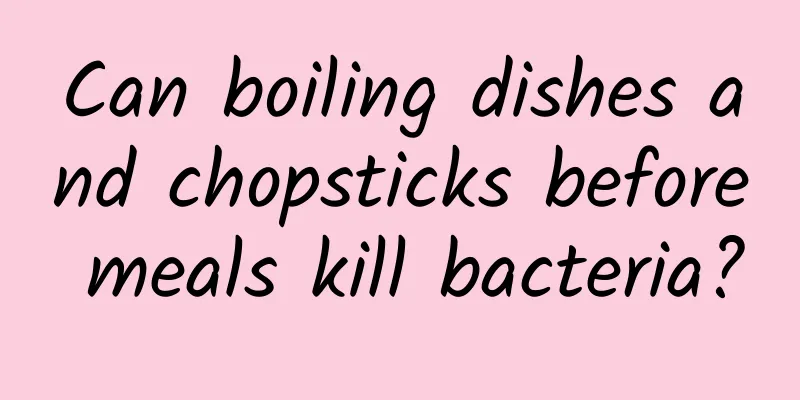Can boiling dishes and chopsticks before meals kill bacteria?

|
What's the first thing you do before dining out? Take photos, of course. Image source: Photo Network In addition to taking photos and checking in, many people are accustomed to using boiling water from the restaurant kettle to scald the bowls, chopsticks, cups and plates to "sterilize" before dining. However, can simply scalding with boiling water really effectively kill bacteria? 01 Does boiled water itself not contain pathogenic bacteria? At normal temperature and pressure, the boiling point of water is 100°C. Generally speaking, boiling water will kill most common pathogens and bacteria at a temperature of 100°C (212°F). However, some bacteria are more heat-resistant and may require higher temperatures and longer times to be completely inactivated. Therefore, to ensure that the boiled water itself does not contain bacteria, the conditions are also very harsh. Image source: Photo Network Taking tap water as an example, since it has undergone scientific purification and sterilization steps before entering thousands of households, except for a few uncommon spores and heat-resistant bacteria that may be difficult to kill, boiling water for 1 to 3 minutes can kill most bacteria, which is enough to ensure the safety of drinking water . Image source: Photo Network Unfortunately, the water in the kettle in the restaurant is not necessarily boiled, nor is it necessarily boiled for 1 to 3 minutes. Therefore, if it is difficult to ensure that the boiled water itself does not contain pathogens, it is probably difficult to achieve the desired effect when using it to wash dishes. 02 Sterilization, what bacteria are killed? Assuming that the boiling water in the kettle is sterile, can we kill bacteria by using it to scald dishes? We need to know which bacteria are to be killed by sterilization and what conditions are required to kill these bacteria. Escherichia coli is a common intestinal bacterium that may cause food poisoning. It can usually be effectively killed by continuous heating at 70°C or above for a period of time. Salmonella is a common foodborne pathogen that can cause intestinal infections. Similar to Escherichia coli, Salmonella is also sensitive to high temperatures of 70°C or above. E. coli concept map Source: Photo Network Streptococcus is a bacterium that is widely found in nature and in human and animal feces. Some strains of Streptococcus may cause infections such as laryngitis and tonsillitis. Heating at 60°C to 70°C for a period of time can effectively inactivate most of the Streptococci. Vibrio cholerae is one of the pathogens of cholera and can be inactivated by continuous heating at 50°C or above for a period of time. Staphylococcus aureus is a common pathogen that may cause skin infections, food poisoning, etc. It is sensitive to high temperatures of 60°C to 70°C, and proper heating can reduce its number. Concept map of Staphylococcus aureus Source: Photo Network It is not difficult to see that the above five common pathogens need to be at least above 70°C and heated continuously for several minutes to be inactivated. In this way, the boiling water in the kettle needs to be hot enough to ensure that it remains above 70°C during the heat exchange process after contact with the air and dishes. But in fact, even if 100°C boiling water is placed at room temperature of 25°C for 3 minutes, the final temperature is difficult to maintain above 70°C. Therefore, this sterilization method is obviously not scientific enough. 03 Do cutlery really carry bacteria? We use boiling water to scald the bowls to kill the bacteria carried on the bowls and chopsticks. So if there are no bacteria on the bowls and chopsticks, wouldn’t the problem be solved? In fact, the general catering industry will use high-temperature boiling + ultraviolet irradiation to disinfect and sterilize. The high-temperature boiling method will not be repeated. Ultraviolet disinfection can kill a series of different types of bacteria, viruses and other microorganisms, including common bacteria such as Escherichia coli, Salmonella, Staphylococcus aureus, as well as viruses such as norovirus, influenza virus, hepatitis virus, etc. Image source: Photo Network The effectiveness of ultraviolet disinfection depends on the wavelength and intensity of the ultraviolet rays used, as well as the characteristics of the target microorganisms. Generally speaking, ultraviolet disinfection can kill bacteria and viruses in a relatively short period of time. Some microorganisms may be more tolerant to ultraviolet rays and require longer exposure. Therefore, when dining out, the bowls and chopsticks that come to our hands have mostly gone through two sterilization processes and can basically be used directly without any worries. Image source: Photo Network Seeing this, you may question: If the catering industry is so well-regulated in sterilization and disinfection, why do we sometimes see food residues on dishes and chopsticks? This is actually a cognitive misunderstanding. 04 Dirty tableware ≠ unsterilized? Generally speaking, the dishes and chopsticks in the catering industry go through two steps: cleaning and sterilization. These two steps play different roles. The main purpose of cleaning dishes and chopsticks is to remove food residues, dirt, grease and other substances to restore the dishes to a clean state. This can reduce the chance of bacterial growth, prevent odors, and provide a better dining experience. The main purpose of sterilizing dishes and chopsticks is to eliminate or significantly reduce bacteria, viruses and other microorganisms on the surface of the dishes, thereby preventing bacterial transmission, food poisoning and other problems. Image source: Photo Network It is important to note that cleaning and sterilization are complementary processes . Cleaning can help remove surface dirt, making sterilization easier; while sterilization can further ensure the hygiene of tableware after cleaning. In a catering environment, cleaning is usually performed first, followed by sterilization to comprehensively ensure food safety and customer health. Sometimes we encounter food residue on tableware, which is often due to mistakes in the cleaning process, not because the sterilization is not done well enough. Image source: Photo Network Although the sterilization and disinfection effect of boiling dishes and chopsticks is very limited, boiling dishes and chopsticks can clean the dust and food residues that may not be cleaned up. It can also play a psychological comfort role. After all, dishes and chopsticks washed by yourself are more reliable to use! Author: Zhou Shuang, 2023 student of Shanghai Science and Technology Museum Science Popularization Star Charging Station Editor: rain Acknowledgements: Dr. Hu Zhiguo from the Center for Excellence in Molecular Cell Science, Chinese Academy of Sciences, provided scientific guidance for this article Title image source: Photo Network |
Recommend
How to position a short video account?
Nowadays, many people regard shooting short video...
Amazing photo: Polar bear "eats whale"!
A simple meal is hard to come by for polar bears ...
Have you taken so many community courses but still can’t build a community?
In the past two years, community operation has be...
The process and methods of building an activity operation plan!
If you want to obtain more traffic and promote su...
How to make a good online event promotion plan?
In marketing psychology, herd mentality, greed fo...
Intel leads the way in the "big adventure" of autonomous driving. What are the chances of BATH accelerating and surpassing others?
Intel, which has pulled the fuse, is igniting a b...
Spreading youth in the bright starry sky: the astronauts behind the Tianzhou-6 cargo spacecraft
Coconut trees, beaches, and waves. Amid the tremb...
Double 12 excellent brand promotion cases are here
For operations partners, the activities at the en...
How to operate self-media content? 3 tips!
All products must contain content, from as small ...
What exactly is the human hemipulmonary virus that has become a hot topic, and how can we deal with it?
Recently, the topic #国产发生人体块病毒菌# suddenly became ...
The case has been solved! It turns out that the big ball spinning on the roof is for this purpose...
On the roofs of many buildings, we often see some...
What creative elements are there in the hot copywriting for the Winter Solstice?
At 0:28 on December 22, 2017 (Friday), we will us...
Why do people dream?
Dreaming is one of the most wonderful experiences...
2021 Yixiantian Chip System (Fourth Issue)
: : : : : : : : : : : : : : : : : : : : : : : : : ...
How much do you know about Facebook operation skills?
Everyone knows how to use Facebook to attract tra...









